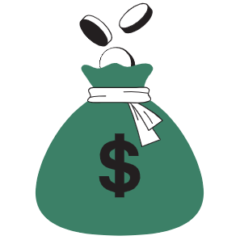Joseph Granville was in the business of prognostication. He was a stock market maven. He knew precisely what to buy and when to buy. He moved markets.
And he let it all know in a newsletter he published called the Granville Market Letter. In that, he gave specific instructions on whether it was time to buy or sell. He had thousands of paying subscribers who would hang on to every word he said.
In his own words…
I’m paid to put you in at the bottom and take you out at the top.
Joseph Granville
In his January 7, 1981 newsletter, just like many times before, he advised his subscribers to sell everything and go short the market. If you don’t know what going short means, you wouldn’t need to know.
His followers heeded that advice. The next day was a massive down day for the stock market.
But what his followers did not know at the time is that was THE time to be buying stocks. The day he made that call, the Dow closed at 980 points. And we know where it is at today.
So, if you got out and stayed out, you lost big. That’s not counting all those dividends you would have collected along the way that you would have of course parlayed into buying more shares. Add all that up and you’ll be massively depressed.
Mark Hulbert who writes the Hulbert Financial Digest chronicles the performance of several investment advisory newsletters from time to time. He estimated that from 1980 to 2005, Mr. Granville’s stock tips lost his followers half a percent a year for 25 straight years. That when the market delivered 12 percent annualized gains.
And his tips for his most aggressive traders basically wiped them out.
Mr. Granville died in 2013, never reversed himself and stayed bearish all along.
Nouriel Roubini, professor of economics at NYU’s Stern School of Business shot to fame by timely predicting the housing market crash of 2008. That call made him an instant celebrity. His predictions were mostly about all the bad times to come. He was hence nicknamed Dr. Doom.
With that newfound confidence, Dr. Roubini gave very specific advice to those contemplating investing during the treacherous days of early 2009.
For the next 12 months, I would stay away from risky assets. I would stay away from the stock market. I would stay away from commodities. I would stay away from credit, both high-yield and high-grade. I would stay in cash or cash like investments such as short-term or longer-term government bonds. It’s better to stay in things with low returns rather than to lose 50% of your wealth. You should preserve capital. It’ll be hard and challenging enough. I wish I could be more cheerful, but I was right a year ago, and I think I’ll be right this year too.
Nouriel Roubini
The Dow gained 23 percent that year, S&P 500 did 24 percent and Nasdaq was up 44 percent. Professor Roubini was right about 2008 but not so right about 2009.
And that is the point.
Dr. Roubini can of course run circles around all of us when it comes to the economy and the markets, but predictions are what they are.
And he has a lot of company.
Bill Gross, who ran the largest bond fund in the world while at PIMCO, announced in early 2011 that he had removed Treasury bonds from its flagship fund stating that bond yields had reached unsustainably low levels.1
Treasury bonds had one of the best years that year in many years. His thesis was right, but markets often dance to their own tune.
David Lereah, the former chief economist at the National Association of Realtors said this in November of 2005.
The good news is that inventory levels are improving and housing supply will come closer to buyer demand in 2006. We expect a healthy and more balanced market next year.
David Lereah
You’d think one could count on his views concerning the future of the housing market.
House prices started their multi-year decline the summer of 2006.
Rich Dad Poor Dad author Robert Kiyosaki made it known about what the stock market was going to do next.
The current stock market rally will probably turn into a dead cat bounce. If the Dow drops below 6,500 points, 5,000 may be the next stop.
Robert Kiyosaki
That was in 2010. And we know the rest of the story.
Then there is Jim Cramer of CNBC. He likely means well but his predictions are oftentimes so wrong that you can now bet against anything he tells the world to do by buying an inverse-Cramer ETF. In March of 2008, he said that Bear Stearns as a company was doing fine. There was no reason to worry. Bear Stearns at the time was trading at 63 dollars a share.
But just six days later, it was sold to JP Morgan Chase for a mere 2 dollars a share.
Lehman Brothers was rated A-Okay by Moody’s right after the de-facto collapse of Bear Stearns.
Three months later, the company went under; a company that survived World Wars, recessions and depressions, a company that has been around almost since the founding of this country couldn’t survive the reckless risk-taking that ran rampant on both Wall Street and Main Street alike.
Then there are headlines like these.
Sell everything ahead of the stock market crash, say RBS economists.
The Guardian
That is a quote by the economists at the Royal Bank of Scotland so not just nobody. Dig a bit deeper in that write-up and they are talking about a potential stock market drop of 20 percent.
Really? They want you to sell everything for that?
That was in January of 2016. Had you acted on any of that, well, you know the story.
That is not to say that the folks behind these forecasts are not some of the best and the brightest. They indeed are. It is just that forecasting with precision on anything with the economy and the markets is an immensely difficult undertaking.
Take getting just the future rate of inflation right. You would think it’s just one number until you realize the extent of the inputs required to predict anything to do with just that one number. Niall Fergusson captures the incredible complexity involved in this Bloomberg opinion piece. An excerpt below…
Consider for a moment what we are implicitly asking when we pose the question: Has inflation peaked? We are not only asking about the supply of and demand for 94,000 different commodities, manufactures and services. We are also asking about the future path of interest rates set by the Fed, which – despite the much-vaunted policy of “forward guidance” – is far from certain. We are asking about how long the strength of the dollar will be sustained, as it is currently holding down the price of U.S. imports.
But there’s more. We are at the same time implicitly asking how long the war in Ukraine will last, as the disruption caused since February by the Russian invasion has significantly exacerbated energy and food price inflation. We are asking whether oil-producing countries such as Saudi Arabia will respond to pleas from Western governments to pump more crude. . . .
We should probably also ask ourselves what the impact on Western labor markets will be of the latest Covid omicron sub-variant, BA.5. UK data indicate that BA.5 is 35% more transmissible than its predecessor BA.2, which in turn was over 20% more transmissible than the original omicron.
Good luck adding all those variables to your model. It is in fact just as impossible to be sure about the future path of inflation as it is to be sure about the future path of the war in Ukraine and the future path of the Covid pandemic.
So easy it ain’t.
Some takeaways hence…
- Never, ever be completely in or out of the markets based on what you see, read or hear. If you cannot handle the heat, tamper down on the sizzle by adding more bonds. You’ll earn less but it’s not going to end your world. But time one of these things wrong and your money world might as well end for a long while.
- Nobody knows as much as you think they know. Or at least nobody knows as much to predict any of these things right. The world economy is a complex, dynamic system. Everything affects everything. The system is perpetually in motion and when it goes out of whack in some corner of the economy, it self-corrects. That is it’s nature. Don’t bet on things staying the way they are for long.
- The best laid financial plans are designed to react in light of what has already happened instead of in anticipation of what is going to happen. If your investment strategy relies on predictions – no matter how credible the source – you are gambling, not investing.
- And last, your plan is your plan. It is based on your situation, your goals, your aspirations and not some sage who’s going to right your ship at a point in time. Making changes based on what a billionaire has to say on TV is the dumbest thing you can do with your money. He can lose 90 percent and he’ll still be fine. Not you.
So, let the prognosticators pontificate all they want. Amuse them, get entertained and then carry on with your life.
Thank you for your time.
Cover image credit – Cottonbro Studio, Pexels
1 The real risk of rising interest rates by Larry Swedroe, CBS News, June 24, 2014

